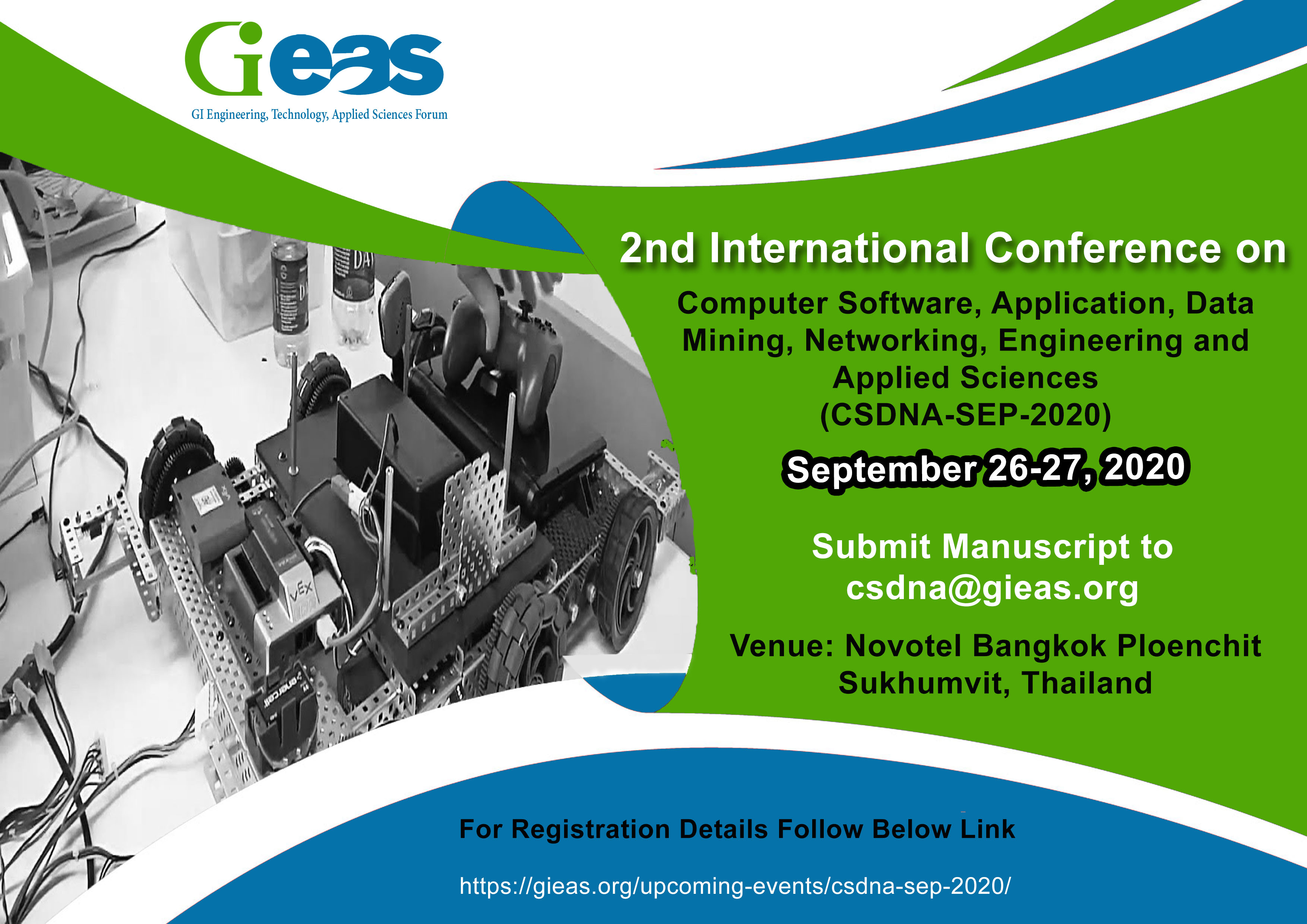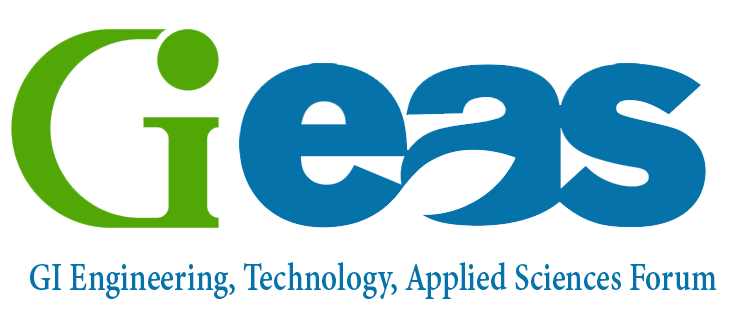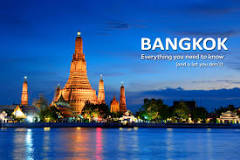Computer Software, Application, Data Mining, Networking, Engineering and Applied Sciences
(CSDNA-SEP-2020)
Venue: Novotel Bangkok Ploenchit Sukhumvit, Thailand
September 26-27, 2020
Abstract Submission Date
September 06, 2020
Full Paper Submission Date
September 10, 2020
July 30, 2020
Venue
Novotel Bangkok Ploenchit Sukhumvit, Thailand
Pay Registration Fee Through Credit Card
csdna@gieas.org
For Presenter registration
Click here
For Attendee registration
Click here
CALL FOR PAPER
The invited talk proposals can be submitted to csdna@gieas.org
The objective of GIEAS Forum is to provide a platform for researchers, engineers, academicians as well as industrial professionals from all over the world to present their research results and development activities in Engineering, Technology and Applied Sciences.
This conference provides opportunities to the researchers to exchange new ideas and application experiences face to face, to establish business or research relations and to find global partners for future collaboration. Boundaries between state of the art and revolutionary innovation constitute the computing frontiers that must be pushed forward to provide the support required for the further advancement of various fields of engineering & technology. This common platform is expected to provide the bases for joint venture among different fields to serve the society in a better way.
All submitted abstracts/ papers / posters will go through a blind peer review process and accepted manuscripts will be published in conference proceedings. Conference proceeding will be submitted to ISI Thomson Reuters Web of Science for consideration and indexation.
Selected conference papers will be published in special / Scopus indexed journals associated with this conference. Associated journals will allocate a special / regular issue for papers submitted to this conference.
CALL FOR SPECIAL SESSION
If you would like to propose a special session to CSDNA, you are invited to send your “special session” proposal to the Program Committee.
Format:
1. Sessions will generally be 1 hour in duration. Time should be included for audience participation.
2. All participants must be registered for the overall CSDNA-2020 conference.
3. Please use the contents below for your session proposal.
4. In case of further clarification or any assistance required before completing the proposal you can email at csdna@gieas.org
At least the moderator and two other panelists must be registered for the conference, so work on the schedule and proceedings can begin.
How to Propose Special Session
CSDNA 2020, Session Proposal must include the following information:
1. Title: Title of your session proposal
2. Aims and Objectives of the Panel: Explain why such a session is relevant to CSDNA and to the Theme of CSDNA. (Max 5-10 lines)
3. Occurrence/Novelty: Please describe either past instances or the novelty of new ventures here. (Max 10 lines)
4. Description: Use this to clarify scope, audience and focus. Give aims and objectives for your session here. This will become the “abstract” for the proceedings and program. (Max 20-25 lines)
5. Event Structure/Agenda: Describe what organizers and participants will do during the session. E.g., will there be a series of fixed presentations and then discussion, and/or will the moderator ask questions to which first the panelists and then the audience may respond. What are the main questions you would ask? (Max 20 lines).
6. Session Members: List all names, affiliations, and emails of all anticipated panel participants, and state if they have accepted the invitation to participate should the panel be accepted. Include the moderator/organizer.
7. Qualifications of panelists: Briefly describe your and your fellow panelists’ backgrounds and qualifications/ areas of expertise in the related research/practitioner domain.
CALL FOR SESSION MODERATORS
We invite scholars to become session moderators in the following tracks:
- Fundamental and Applied Sciences
- Material Science and Engineering
- Electrical and Electronic Engineering
- Computer Engineering and Sciences
- Mechanical Engineering
- Biological Engineering
- Chemical Engineering
- Civil Engineering
- Environmental Engineering
All interested scholars should send their consent to csdna@gieas.org by mentioning their area of interest. For this voluntary service, all session moderators will be awarded a certificate of appreciation by the CSDNA 2020 secretariat.
GUIDELINES FOR SESSION CHAIRS
In this International Conference “Computer Software, Application, Data Mining, Networking, Engineering and Applied Sciences” several sessions will be held based on different themes and areas of interest.
- Session chairs are requested to kindly check the Schedule of conference.
- Check the date, room and time of the sessions that they are chairing.
- Main task of session chair is to motivate the presenter/researcher to share his/her knowledge on the particular topic and also make conducive environment so the participants may have an intellectual discussion on the subject.
- Session chair can share his/her own knowledge, research, experience, observations very briefly if time permits.
- Please ensure your availability at assigned room at least 5-10 minutes prior to the beginning of session. This will help you to acquaint with the working of Laptop and multimedia etc. Please contact the control room, in case of any problem.
- Please choose your seat in front row, so participant may see and interact with you easily.
- Please introduce yourself and greet the participants of session.
- Make attendance of presenters of your session to ensure their presence in the room.
- Make an announcement regarding the allocation of time to each presenter. Time for each presentation is of 10 minutes followed by 5 minutes of Question & Answer session. However, session chair may extend the time of presentation keeping in view the allotted time for session.
- Session chair is responsible for session to be completed on time.
- Before inviting presenter(s), announce their full name(s) and the title of the paper.
- Best session paper has already been decided by our distinguished reviewers and his/her name will be conveyed to you, you will announce this at the end of session and present a certificate to researcher.
- You will have to decide “Best Presenter of Session” by filling in the evaluation form provided to you and certificate will be awarded in the closing ceremony.
- At the end of session, distribute the certificates of presentation, convey expression of thanks on your personal and GIEAS behalf to the presenters and the participants.
- In case of any sort of confusion, please contact conference chair or management of GIEAS.
CALL FOR REVIEWERS
We invite scholars to become session moderators in the following tracks:
- Fundamental and Applied Sciences
- Material Science and Engineering
- Electrical and Electronic Engineering
- Computer Engineering and Sciences
- Mechanical Engineering
- Biological Engineering
- Chemical Engineering
- Civil Engineering
- Environmental Engineering
All interested scholars should send their consent to csdna@gieas.org by mentioning their area of interest. For this voluntary service, all reviewers will be awarded a certificate of appreciation by the CSDNA 2020 secretariat.
PLAGIARISM POLICY
According to plagiarism policy of CSDNA-2020 all full papers considered for proceeding publication will go through plagiarism check using “TURNITIN” software and acceptable level of similarity index is 20%. Irrespective of initial abstract acceptance, full papers with more than 20% similarity indexed will not be published in online full paper proceeding. All authors are deemed to be individually and collectively responsible for the content of papers published by CSDNA-2020. Hence, it is the responsibility of each author to ensure that papers submitted to CSDNA-2020 should comply with the ethical standards with respect to plagiarism.
TYPES OF PRESENTATION
You can present your projects in three modalities: in person (either oral or poster presentation) or virtually (non-attending authors).
ORAL PRESENTATION
Each presentation will last 10-15 minutes including 3 minutes for questions and discussion. You will be informed of your session reference and the time of your presentation about 2 weeks before the event. If your personal circumstances restrict you to presenting your paper on a specific date, please send us an email with your request as soon as possible.
Presentation instructions
All the oral presentations should be done in English, the official language of the event.
Each talk is 15 minutes long. We recommend dedicating 12 minutes to the presentation and 3 minutes to open discussion.
The following points should be taken into consideration when preparing your oral presentation:
- Ensure that you are available at least 30 minutes before the session starts on the day of the conference.
- The equipment available will be a PC and Data Projector.
- The recommended software to be used is PowerPoint or Adobe Acrobat (pdf).
Recommendations to make a good oral presentation
- Its contents should be structured and have the following parts: title, introduction, methods, results, discussion, etc.
- Presentations should not contain full paragraphs of text. Use a bulleted list or outline format and elaborate on the points in your talk.
- Every slide should contain a title that summarizes the information presented on the slide.
- Create a logical flow for your presentation.
- Used fonts should be in sans serif type (like Arial or Helvetica). This is because, when projected on a screen, letters lose some of their sharpness, and serif type (like Times) can look muddy.
- Use large fonts, as big as realistically possible. Small fonts are hard to read.
- Use contrasting colors either a dark background with light text or a light background with dark text.
- Avoid busy backgrounds that will make the text hard to read. Keep the background simple.
- Limit your graphics to 1-3 per page. Too many graphics can be distracting.
- Avoid all CAPITAL LETTERS IN YOUR TEXT. It will look like you’re shouting.
- Include a good combination of words, pictures, and graphics. Variety keeps the presentation interesting.
- Slides are designed to supplement your presentation, not to BE your presentation. Keep it simple, and don’t read your presentation word for word from your slides.
- Fill out a storyboard before you begin to put your presentation together. It will help you stay organized, and things will get done faster.
- As the total duration of your presentations is 15 minutes, the recommended number of slides for your PowerPoint file is 10/15.
Style
Don’t read from the slide – vary your choice of words.
- Don’t talk to the screen; maintain eye contact with the audience.
- Use a laser pointer to indicate salient features of the slide as you speak (there will be one provided in the session room).
- Speak loudly and articulate.
POSTER PRESENTATION
Maximum poster size is 36 inches wide by 48 inches high (3 ft. x 4 ft.). You must provide your own printout of the poster itself. You are requested to set up your poster in the morning prior to the Opening ceremony and remove it at the end of the session. One of the paper author or co-authors must be present and available for discussion at the poster session. Posters will be on display in the conference room.
Presentation instructions
- All posters should be written and presented in English, the official language of the event.
- Poster sessions will provide an opportunity for authors to display the results and conclusions of their papers.
- Your poster will be exhibited during the conference. Authors are expected to be at their poster during the session.
- Posters will be listed by session in the Conference Programme and Proceedings.
- We recommend that you provide small envelopes for distributing your business cards and collecting business cards from those who request additional information. This is a good way of inviting and encouraging interaction with your audience. You may also wish to provide copies of a short summary of your presentation for distribution.
Dimensions and format
- Posters should be printed and brought by each author to the conference.
- The poster can be up to 36 inches wide by 48 inches high (3 ft. x 4 ft.).
- We will provide materials for attaching posters. However you can bring your own if you prefer.
- Your poster should be readable from a distance of 2 metres.
VIRTUAL PRESENTATION
Those whose abstracts are accepted and they cannot attend the conference, are allowed to make a Skype presentation or share a video presentation. Your abstract will be included in the proceedings and your full paper will be considered for publication.
Presentation instructions
- Virtual presentations will not be simultaneous. Virtual authors will be able to present their papers as follows:
- In addition to the paper submission, virtual authors submit a PowerPoint presentation (with video and/or audio). These presentations will be played on the conference day, in a related session, and presenters will be connected via Skype. Thus, the audiences will be able to ask their questions to the presenter of the virtual presentation.
- Virtual authors could be contacted by email by conference participants in the case of technical questions regarding their virtual paper.
KEYNOTE SPEAKER

Prof. Jayson E. Lannu, MM, DMS, (PhD)
De La Salle- College of Saint Benilde, Philippines
Jose Rizal University, Philippines
Prof. Jayson Lannu is currently a professor at Jose Rizal University in the Philippines and an Assistant Professorial Lecturer V at the De La Salle- College of Saint Benilde. He finished his Bachelor’s degree major in Financial Management at Saint Louis University and had his Master’s degree in Management at Technological University of the Philippines. He had academic units in Doctor of Management Science and a Doctor of Philosophy degree major in Business Management under a scholarship granted by the Commission on Higher Education (CHED). He had several researches published in reputable international journals and has been a peer research reviewer for several publications and research conferences. His field of expertise and interests are: business education, economics, finance, management and marketing and he had been a faculty member of different Universities and Colleges in the Philippines. He currently had international and local publications indexed in the International Scientific Indexing (ISI), Google Scholar, Eurasian Scientific Index (ESJI) and Crossmark that focused on the impact of ASEAN integration to the economic development of the Philippines and made significant contributions in the curriculum development of several programs with the results of his researches on educational pedagogy and methodologies specifically in business education.
REGISTRATION & FEE
IMPORTANT NOTE:
Registration fee is non-refundable and it includes charges for conference participation only. Arrangements and costs of visa, travelling and accommodation are not the responsibility of the organization, they will be borne by the individual author. We must receive the full Registration fee. Transaction cost will be borne by the authors.
Please clearly mention the paper ID on payment invoice and email the scanned copy at csdna@gieas.org
You may also pay the registration / publication fee through credit card by following the link below:
Pay Registration fee through Credit Card
| SR. No | International Delegates | Early Bird Fee (July 30, 2020) | Normal Fee |
|---|---|---|---|
| 1 | All Participants / Faculty members / Professionals / Practitioners | US$ 420 | US$ 475 |
| 2 | Student (must provide copy of student ID card) | US$ 315 | US$ 370 |
| SR. No | Thai Participants | Early Bird Fee (July 30, 2020) | Normal Fee |
| 3 | All Participants / Faculty members / Professionals / Practitioners | US$ 370 | US$ 420 |
| 4 | Thai Students (must provide copy of student ID card) | US$ 265 | US$ 315 |
| 5 | Additional Paper Presentation (local & international) | US$ 210 | US$ 265 |
| 6 | Attendee | US$ 315 | US$ 370 |
Registration Fee Includes:
- Conference Material & Program
- Conference Bag
- Certificate of Presentation
- Lunch and Coffee Breaks
- Full Paper Proceeding Soft Form
- Abstract Proceeding Hard Form


